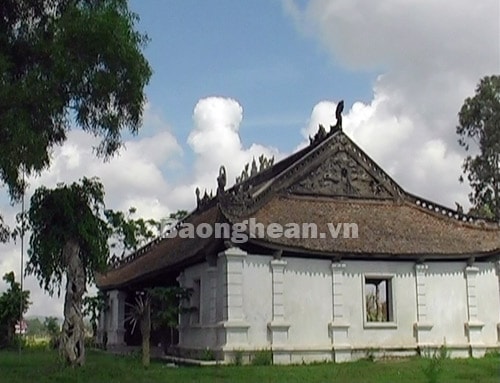Sung Communal House - A unique architectural heritage
Located in the North of Yen Thanh district, Lang Thanh commune has an ancient communal house known to many people near and far, named Sung Communal House. Like many other communal houses in the Vietnamese countryside, Sung Communal House in Lang Thanh commune is a large communal house with architectural and artistic value, existing for over 500 years.
(Baonghean) -Located in the North of Yen Thanh district, Lang Thanh commune has an ancient communal house known to many people near and far, named Sung Communal House. Like many other communal houses in the Vietnamese countryside, Sung Communal House in Lang Thanh commune is a large communal house with architectural and artistic value, existing for over 500 years.
The ancient village of Quy Lang was called Ke Sung, an ancient village hidden in a unique position, with advantages in war and potential for economic development, so Ke Sung soon became one of the centers of Chau Dien. When the Tang Dynasty took Ham Hoan district in the district to establish Dien Chau, making it one of the 12 districts of An Nam Protectorate in 679, until the end of the Dinh Dynasty in 979, continuously for 3 centuries, the headquarters of Dien Chau was located in Ke Sung.
In November 1583, the people of Quy Lang village joined forces to build a communal house as a place for meetings and cultural activities. Originally, the communal house was made of bamboo and thatch, located in the middle of a densely populated area. Around the communal house were villages, banyan trees, ferry docks, and the winding Sung River, like a soft silk strip carrying heavy alluvium to cool the fields. Along with many unique ancient architectures such as stone bridges, village gates, etc., the unique and quintessential beauty of the ancient communal house was honored. In 1797, the village built an additional sanctuary to worship the village's tutelary god. During its existence and development, the communal house was renovated in the years: 1637, 1677, 1787, 1913, and in 1929, the communal house was restored to its current beauty. This is clearly recorded in the steles here.

By early 1930, the restoration of the communal house was completed. The communal house has Nguyen Dynasty architecture on a massive scale, 24.7 meters long and 11.2 meters wide. The house frame is made of large ironwood.
Regarding art, all parts of the communal house such as the roof ridge, the beams, the rafters, the lower beams, the rafter... are elaborately decorated by artisans, demonstrating high sculpting and carving skills. On the roof ridge, the beams and the two gable walls, using locally available materials such as lime and molasses, artisans mixed together to create images of dragons and phoenixes dancing in vivid reliefs.
Decorated on wood, the theme expressed here also revolves around familiar motifs such as: "Four Spirits", "Four Seasons", but by arranging the panels in a harmonious and balanced way, exuding a lively look that attracts viewers.
There is an interesting thing, the communal house was made by two groups of workers following a predetermined pattern, many of the carvings have the same theme, but the spirit and expression are completely different. The common point is that they all exude deep humanity, expressing the tradition of a nation, which is: Noble, pure, loyal, honest, resilient and good-natured.
Through many historical ups and downs, Sung communal house still retains its pristine beauty associated with the historical evidence of the land and people of Quy Lang. In the years 1930-1931, the communal house was the secret meeting place of the Quy Lang Party cell - one of the first cells in Yen Thanh district. During the period 1932-1933, the French colonialists used Sung communal house as a base. Here, they imprisoned, arrested and tortured over 100 party members. On August 12, 1945, at the ancient communal house, the people of Quy Lang gathered to organize the seizure of power from the feudalists. At the same time, it was also the place to organize major movements such as: Golden Week, Weapons Week, Resistance Bonds, National Bonds, a school, and a place to store rice for the resistance war against the French. During the resistance war against the US, for a long time, the communal house was the site of a textile factory of Military Region 4. Today, the communal house is the center of many activities imbued with local cultural identity such as: worshiping gods, processions, singing, ca tru, cheo, wrestling, and is a place for meetings of mass organizations... In 2004, Sung Communal House was recognized as a National Historical and Cultural Relic. In 2010, with the support of the state, the local government invested in renovating and upgrading a number of items, in order to preserve valuable documents, helping scientists learn and research the architectural art of ancient cultural heritage and also a place to educate traditions for future generations.
Sun






